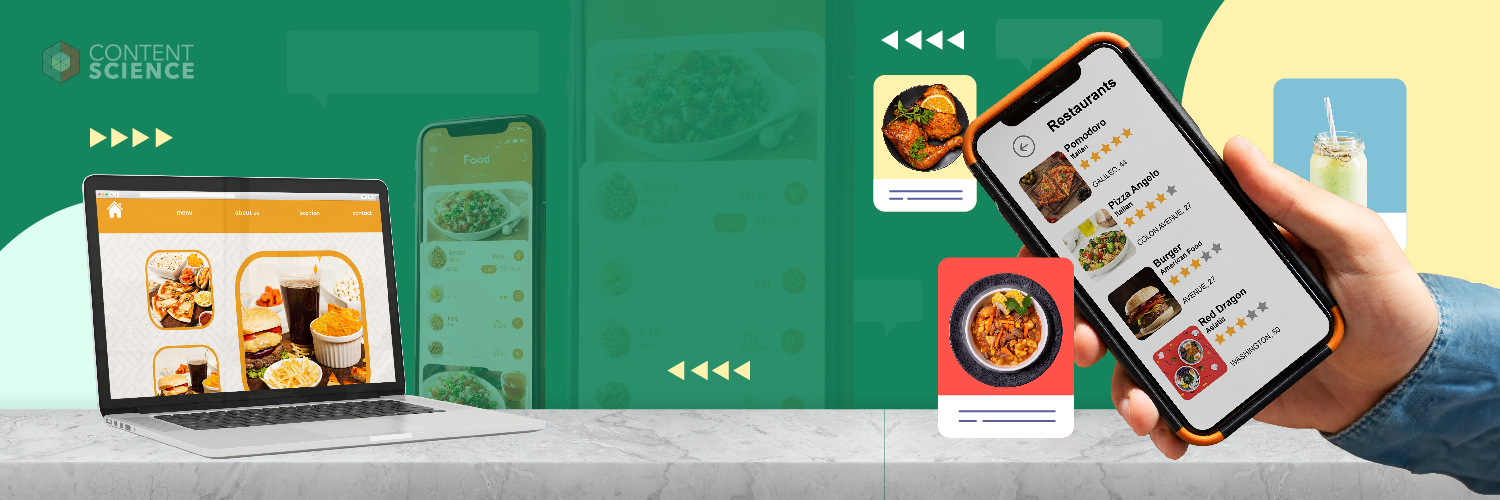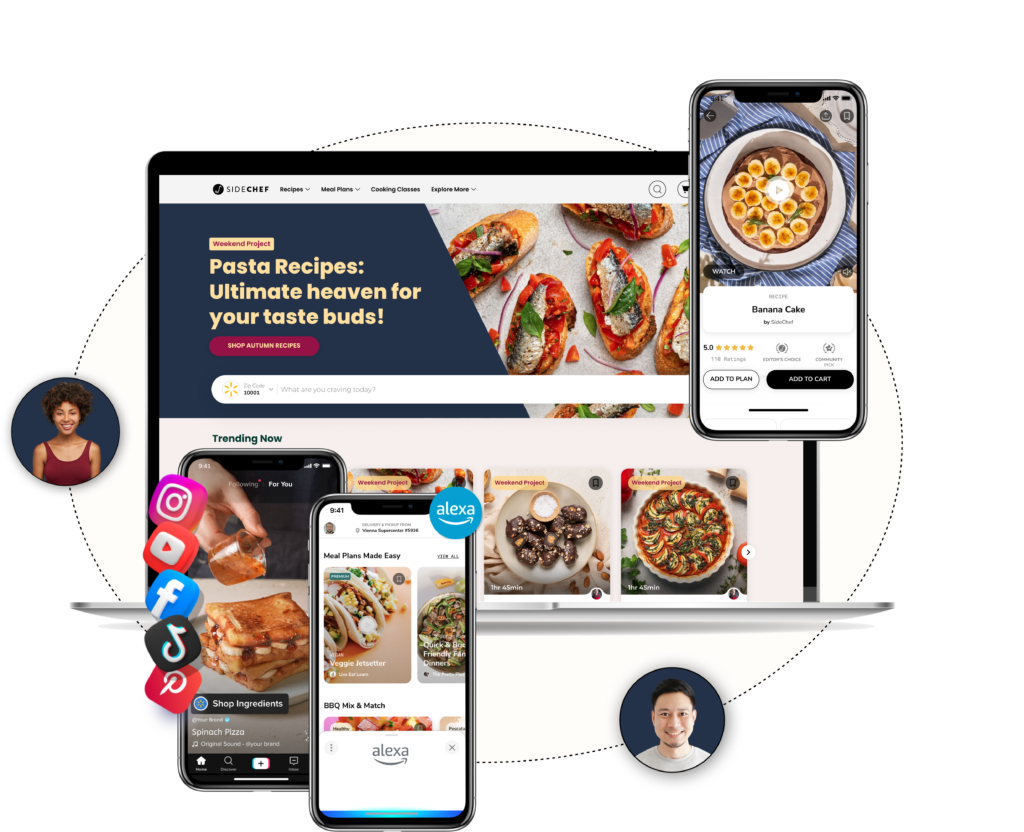
In the fast-evolving world of food technology, 2024 is set for a culinary revolution, with content engineering leading the way. As we navigate this transformative year, we stand on the brink of a remarkable evolution in our interaction with food technology.
In a dynamic arena where innovation knows no bounds, key industry players are making significant strides across multiple dimensions, thus reshaping our food experiences. The anticipation is palpable as we witness the seamless fusion of technology and gastronomy, orchestrated by content engineering practices that breathe life into new cooking experiences. From personalized recipe recommendations to AI-generated culinary content, these trends will reshape how we discover, create, and enjoy food, the entire culinary journey.
Here are the top 9 emerging content engineering trends you should keep an eye out for and add to your innovation strategies in 2024. Whether you’re in tech, healthcare, or any industry under the sun, these trends will give you plenty of food for thought.
1. (Even More!) Personalized Recipe Recommendations
Content engineering is at the core of personalized recipe recommendations, a staple in food tech. To provide users with tailored suggestions, SideChef employs content engineering practices to curate and analyze vast recipes and user data databases. Food tech platforms use advanced algorithms and machine learning techniques to understand user preferences, dietary restrictions, and past cooking experiences.
With a database of thousands of recipes and a robust recommendation algorithm, SideChef personalizes meal suggestions based on a user’s dietary preferences, allergies, and cooking history. For instance, if you’re a vegetarian who loves Italian cuisine and recently experimented with pasta dishes, SideChef will curate pasta recipes that align with your tastes, ensuring a tailored cooking experience.

As food tech continues to evolve, expect to see more platforms harness the power of algorithms to cater to individual tastes, dietary preferences, and past cooking experiences.
2. AI-Generated Culinary Content
AI-generated culinary content isn’t a one-trick pony. Food tech as a whole is embracing automation. Content engineering involves creating and structuring content data in a way that AI models can understand and utilize. Content engineers design data pipelines and ensure consistency in content quality. For AI to generate accurate and engaging recipe descriptions, cooking tips, and blog posts, content engineering practices are essential to effectively manage the underlying content database.
While the trend of AI-generated culinary content has gained momentum in 2023, it’s important to note that AI in cooking platforms is not a recent development. In fact, the use of artificial intelligence in culinary applications predates the generative AI era. AI has been a staple in enhancing the user experience, providing useful features, and even contributing to creative culinary exploration.
Long before generative AI, tech companies used recommendation algorithms to suggest recipes to users based on their past cooking history and preferences. These algorithms considered ingredient availability, dietary restrictions, and user feedback to deliver personalized recipe recommendations, allowing users to discover new dishes aligned with their tastes and nutritional needs.
Integrating AI-driven timers and temperature control systems into kitchen appliances like ovens and sous-vide machines helps users achieve precise cooking results by adjusting the cooking time and temperature based on the type of food and desired level of doneness. They ensure that even novice cooks can perfectly prepare dishes, eliminating guesswork and potential gastronomic flops.
AI-powered ingredient substitution models have also been a handy feature in cooking platforms. They analyze the ingredients available to the user and recommend suitable replacements if a specific ingredient is missing. This feature reduces food waste and allows users to adapt recipes to their pantry’s contents, making cooking more convenient and flexible.
In 2024, the AI-generated culinary content trend will build upon this foundation by automating the creation of recipe descriptions, cooking tips, and even blog posts. By leveraging generative AI, food tech platforms enhance efficiency and ensure a consistent and engaging user experience. As a result, users can explore a more comprehensive array of culinary content and enjoy a more immersive journey into the world of food.
The SideChef platform and those powered by SideChef technology have already begun employing machine learning to generate these culinary experiences and even automate recipe optimization and shoppability. Using models trained by machine learning reduces the burden on content creators and allows them to focus on what they do best — experimenting in the kitchen. We can anticipate increased use of AI to create recipe descriptions, cooking tips, and even food-related articles across various platforms, reducing the need for manual content generation.
3. Augmented Reality in the Kitchen
With the ability to overlay digital information and visuals onto the physical world, Augmented reality (AR) cooking guides will take culinary experiences to a whole new level. Imagine preparing a complex dish like sushi for the first time. With AR, your smartphone or smart glasses can display 3D models of each step, making it easy to follow along. You can see exactly how to roll the sushi, where to place the ingredients, and how to cut it, all superimposed on your kitchen counter.
AR can recognize ingredients as you place them on your countertop. It can identify each item and provide information about it, such as its nutritional content, origin, and recommended uses. For instance, if you’re using an unfamiliar spice, the AR guide can pop up with details and suggestions on incorporating it into your dish.
With AR, you can set cooking timers and receive alerts without glancing at a separate device. If you’re searing a steak, the AR headset or app can display a countdown timer right in your field of vision and notify you when it’s time to flip the steak or take it off the heat, ensuring that you always cook your food exactly right.
AR cooking guides can feature virtual culinary classes and guest chefs. Users can participate in cooking lessons from renowned chefs, with the AR overlaying their instructions, tips, and demonstrations onto your workspace, making it feel like a world-class chef is guiding you through the process!
By structuring content through content engineering practices today, SideChef is laying the foundation for a future where culinary AR guides are integral to our cooking experiences. These immersive experiences not only make cooking more accessible but also reduce the need to switch between screens, keeping your hands on the ingredients and your eyes on the prize. Look out for Content engineers collaborating with AR developers to ensure that the visual and instructional content aligns perfectly with the physical cooking space.
4. Sustainability Metrics Integration: A Greener Plate
Integrating sustainability metrics is a trend with wide-reaching implications for food tech. Expect more platforms to incorporate sustainability data, such as carbon footprints and the eco-friendliness of ingredients, providing users with the information they need to make eco-conscious choices.

To help users make an impact during their cooking experience, content engineers structure data related to ingredient sourcing, environmental impact assessments, and nutritional values. By effectively organizing and presenting this data, food tech platforms empower users to make informed, sustainable choices.
SideChef champions the integration of sustainability metrics. As the demand for eco-conscious choices rises, SideChef provides users with guidance on the sustainability of their recipes. By quantifying factors like how to reduce food waste, SideChef empowers users to make environmentally responsible choices when selecting ingredients and preparing meals.
5. Real-Time Nutritional Analysis: Data-Driven Dining
Food tech companies recognize the importance of providing users with immediate access to information about the nutritional value of their recipes. Real-time nutritional analysis relies on content engineering practices to manage extensive databases of nutritional information. Content engineering structures data related to ingredients, including calorie counts, macronutrient breakdowns, and vitamin content. Software systems then use this structured data to provide users with on-the-fly nutritional analysis, helping them make informed dietary choices.
As you browse recipes and plan your meals, SideChef provides essential nutritional information. With such data, users can easily tailor their meals to match their dietary goals, whether losing weight, building muscle, or maintaining a balanced diet. As 2024 unfolds, expect to see more platforms worldwide offering this valuable feature.
6. Multilingual Recipe Translation: Global Flavors at Your Fingertips
Don’t be surprised to see food tech platforms making global cuisine more accessible by offering on-the-fly translation of recipes. By structuring recipe content in multiple languages and providing effective translation databases, content engineering will enable platforms to convert recipes into different languages seamlessly. This way, users can explore global cuisines without language barriers, creating a more inclusive and accessible culinary experience.
Multilingual recipe translation is an indispensable trend that transcends language barriers, and platforms like SideChef are already making significant strides in this space. SideChef, for example, is powering experiences in multiple languages and regions, bringing global culinary content closer to home. Their commitment to inclusivity and accessibility is evident in their efforts to offer recipe translations that make international cuisines more approachable. As the demand for cross-cultural culinary exploration continues to grow, expect platforms like SideChef to expand their multilingual capabilities even further, enriching the culinary journey for users worldwide.
7. Interactive Cooking Challenges: Gamifying the Kitchen
Interactive cooking challenges stand to become popular, and content engineering will be pivotal in supporting their innovation. An early sign of the popularity of interactive cooking challenges is the growing demand for personalized content. Users want challenges that suit their skill level, dietary preferences, and culinary interests. Content engineering will help customize challenges by structuring content to allow the platform to recommend suitable challenges to individual users. This personalization enhances user engagement and satisfaction.
Early signs that interactive cooking challenges will be popular in the future include the increasing adoption of gamified features in food tech platforms. As users seek culinary inspiration and enjoyable cooking experiences, the demand for challenges that combine education with entertainment is growing. The success of existing challenges and the level of user participation also indicate the trend’s potential popularity. The more users engage with and enjoy these challenges, the more likely they will become a staple in food tech. Content engineering will be instrumental in shaping these challenges and optimizing the user experience, ensuring they remain engaging and enjoyable for home chefs.
8. Voice-Activated Recipe Guidance: Hands-Free Help
Voice-activated recipe guidance is a trend that has been on the rise, providing home chefs with a convenient and intuitive way to interact with cooking platforms. SideChef, an early innovator in this field, introduced hands-free guidance at the launch of the app in 2013, over a decade ago. Imagine standing in your kitchen, craving a homemade pizza. You decide to try out a new recipe but are short on time. So, you say, “Alexa, show me pizza recipes.”
In response, Alexa swiftly presents you with a list of pizza recipe options. You choose a SideChef recipe, and with a simple voice command like “next step,” you effortlessly navigate through the cooking process. This hands-free experience, powered by SideChef’s early innovations in voice-activated guidance, not only streamlines your cooking journey but also makes it more enjoyable and accessible, emphasizing that the future of cooking is as much about voice convenience as it is about savoring the flavors. This scenario underscores voice-activated recipe guidance’s practicality and user-friendly nature, indicating a promising trend likely to gain further popularity. Content engineering continues to be pivotal in structuring the content and data enabling these seamless voice interactions and ensuring that recipe databases structuring that voice assistants can understand and interpret.

With voice-activated recipe guidance, SideChef aims to make cooking more convenient. Their integrations with voice assistants and smart kitchen devices allow users to access hands-free cooking guidance, ingredient conversions, and cooking timers. This feature simplifies the cooking process and caters to the increasing demand for smart kitchen solutions.
9. Predictive Flavor Innovation: The Taste of Tomorrow
Content engineering will extend to predictive flavor innovation, where AI and data analytics will help create new and exciting taste combinations. Imagine an AI-driven chef that can predict and recommend flavors you’ve never imagined. Content engineers will work towards structuring vast datasets of flavor profiles, ingredient combinations, and user preferences. AI and data analytics would then utilize this structured data to predict and recommend new and exciting taste combinations, pushing the boundaries of culinary creativity.
In 2024, the fusion of content engineering and food technology will reshape the culinary landscape. It will be the backbone of these food tech trends, facilitating the structuring, organization, and optimization of data and content that powers its innovative features and capabilities. It’s through these practices that food tech platforms can deliver enhanced and personalized experiences to users.
SideChef, with its innovative approach, exemplifies how these trends transform how we discover, create, and enjoy food. As technology advances, the world of cooking and gastronomy is becoming more accessible, sustainable, and engaging. As we savor each bite, we’ll appreciate the content engineering that has brought it to our tables, making cooking a weeknight dinner memorable in a whole new way.
Events, Resources, + More
The Ultimate Guide to End-to-End Content
Discover why + how an end-to-end approach is critical in the age of AI with this comprehensive white paper.
The Content Advantage Book
The much-anticipated third edition of the highly rated book by Colleen Jones is available at book retailers worldwide. Learn more!
20 Signs of a Content Problem in a High-Stakes Initiative
Use this white paper to diagnose the problem so you can achieve the right solution faster.
Upskill with Content Science Academy
Training for modern content roles through on-demand certifications + courses or live workshops.






Comments
We invite you to share your perspective in a constructive way. To comment, please sign in or register. Our moderating team will review all comments and may edit them for clarity. Our team also may delete comments that are off-topic or disrespectful. All postings become the property of
Content Science Review.